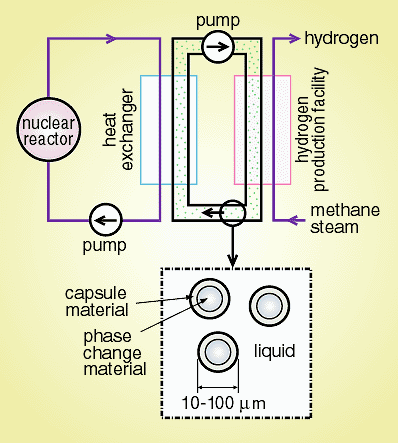A new heat carrier with a high heat capacity is strongly desired for
the transportation of nuclear heat, because nuclear plants produce a
large amount of heat. The new heat carrier has to possess the ability
to carry a large amount of heat with a small amount of carrier. We were
successful in inventing a new heat carrier which is a suspension of
spherical micro-capsules in a liquid (Fig. 7-6). The micro-capsules
contain phase change material. The phase change material in the micro-capsule
can absorb a large amount of heat when it changes from liquid to solid
phase because the latent heat of the phase change material is quite
high. By suspending the micro-capsules in a liquid we were also able
to retain good mobility of the heat carrier. This new heat carrier is
able to carry an amount of heat 1.5 times larger than the liquid itself
can carry. Theoretically, it is possible to achieve a bigger increase
in the heat transportation capacity if we succeed in devising new methods
to encapsulate phase change materials possessing larger latent heat
in micro-capsules.
We found that the new heat carrier has another excellent feature which
is a high heat transfer coefficient. That is, the new heat carrier can
transfer heat with a high efficiency in a heat exchanger from the primary
heat transportation circuit to the second circuit, especially when the
temperature difference between the primary and the secondary circuit
is very small. The heat transfer coefficient of the new heat carrier
can achieve a high heat transfer coefficient 40% higher than a liquid
can when there is a small temperature difference between the circuits
(Fig. 7-7). This property is very important for the utilization of nuclear
heat, because we have many situations where we have to utilize low temperature
exhaust heat from nuclear plants. That is, when we consider the utilization
of nuclear heat with a high efficiency without wasting heat energy from
the plants, we have, for instance, to utilize residual low temperature
heat coming from electric power generation units in the nuclear plants.
In the utilization of low temperature exhaust heat, we need a heat carrier
which can transfer heat from the primary nuclear circuit to the secondary
heat utilization circuit with high efficiency especially in a small
temperature difference condition.
The new heat carrier we invented has those superior features; a high
capacity of heat transportation and a high efficiency of heat transfer. |

